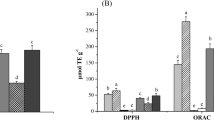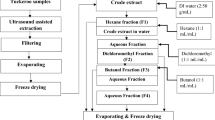Abstract
Arbutus unedo, Prunus spinosa, Rosa micrantha and Rosa canina are good sources of phenolic compounds, including anthocyanins. These compounds have potent antioxidant properties, which have been related to anticancer activity. Herein, the in vitro antioxidant and antitumor properties of enriched phenolic extracts (non-anthocyanin phenolic compounds enriched extract- PE and anthocyanins enriched extract- AE) of the mentioned wild fruits were evaluated and compared. PE gave higher bioactive properties than the corresponding AE. It was observed a high capacity of A. unedo phenolic extract to inhibit lipid peroxidation in animal brain homogenates (EC50 = 7.21 μg/mL), as also a high antitumor potential against NCI-H460 human cell line (non-small lung cancer; GI50 = 37.68 μg/mL), which could be related to the presence of galloyl derivatives (exclusively found in this species). The bioactivity of the studied wild fruits proved to be more related to the phenolic compounds profile than to the amounts present in each extract, and could be considered in the design of new formulations of dietary supplements or functional foods.

Similar content being viewed by others
Abbreviations
- DPPH:
-
2,2-Diphenyl-1-picrylhydrazyl
- FBS:
-
Foetal bovine serum
- HBSS:
-
Hank’s balanced salt solution
- SRB:
-
Sulforhodamine B
- TBARS:
-
Thiobarbituric acid reactive substances
- TCA:
-
Trichloroacetic acid
References
Rice-Evans CA, Miller NJ, Paganga G (1997) Antioxidant properties of phenolic compounds. Review. Trends Plant Sci 2:152–159
Yao LH, Jiang YM, Shi J, Tomás-Barberán FA, Datta N, Singanusong R, Chen SS (2004) Flavonoids in food and their health benefits. Plant Foods Hum Nutr 59:113–122
Szajdek A, Borowska EJ (2008) Bioactive compounds and health-promoting properties of berry fruits: a review. Plant Foods Hum Nutr 63:147–156
Carocho M, Ferreira ICFR (2013) The role of phenolic compounds in the fight against cancer- a review. Anti-Cancer Ag Med Chem 13:1236–1258
Scalbert A, Williamson G (2000) Dietary intake and bioavailability of polyphenols. J Nutr 130:2073–2085
Carocho M, Ferreira ICFR (2013) A review on antioxidants, prooxidants and related controversy: natural and synthetic compounds, screening and analysis methodologies and future perspectives. Food Chem Toxicol 51:15–25
Kong JM, Chia LS, Goh NK, Chia TF, Brouillard R (2003) Analysis and biological activities of anthocyanins. Phytochemistry 64:923–933
Guimarães R, Barros L, Dueñas M, Carvalho AM, Queiroz MJRP, Santos- Buelga C, Ferreira ICFR (2013) Characterization of phenolic compounds in wild fruits from Northeastern Portugal. Food Chem 141:3721–3730
Bnouham M, Merhfour FZ, Legssyer A, Mekhfi H, Maallem S, Ziyyat A (2007) Antihyperglycemic activity of Arbutus unedo, Ammoides pusilla and Thymelaea hirsuta. Pharmazie 62:630–632
Carvalho AM (2010) Plantas y sabiduría popular del Parque Natural de Montesinho. Un estudio etnobotánico en Portugal. Biblioteca de Ciencias 35. Madrid: Consejo Superior de Investigaciones Científicas
Orhan DD, Hartevioğlu A, Küpeli E, Yesilalada E (2007) In vivo anti-inflammatory and antinociceptive activity of the crude extract and fractions from Rosa canina L. fruits. J Ethnopharmacol 112:394–400
Fortalezas S, Tavares L, Pimpão R, Tyagi M, Pontes V, Alves PM, McDougall G, Stewart D, Ferreira RB, Santos CN (2010) Antioxidant properties and neuroprotective capacity of strawberry tree fruits (Arbutus unedo). Nutrients 2:214–229
Mendes L, Freitas V, Baptista P, Carvalho M (2011) Comparative antihemolytic and radical scavenging activities of strawberry tree (Arbutus unedo L.) leaf and fruit. Food Chem Toxicol 49:2285–2291
Barros L, Carvalho AM, Morais JS, Ferreira ICFR (2010) Strawberry-tree, blackthorn and rose fruits: detailed characterization in nutrients and phytochemicals with antioxidant properties. Food Chem 120:247–254
Guimarães R, Barros L, Carvalho AM, Ferreira ICFR (2010) Studies on chemical constituents and bioactivity of Rosa micrantha: an alternative antioxidants source for food, pharmaceutical, or cosmetic applications. J Agric Food Chem 58:6277–6284
Fujii T, Ikeda K, Saito M (2011) Inhibitory effect of rose hip (Rosa canina L.) on melanogenesis in mouse melanoma cells and on pigmentation in brown guinea pigs. Biosci Biotechnol Biochem 75:489–495
Tumbas VT, Čanadanović-Brunet JM, Četojević-Simin DD, Ćetković GS, Dilas SM, Gille L (2012) Effect of rosehip (Rosa canina L.) phytochemicals on stable free radicals and human cancer cells. J Sci Food Agric 92:1273–1281
Castroviejo S et al (2004) Flora Iberica. Plantas vasculares de la Península Ibérica e Islas Baleares, vol IV. CSIC, Real Jardín Botánico
Dias MI, Barros L, Sousa MJ, Ferreira ICFR (2011) Comparative study of lipophilic and hydrophilic antioxidants from in vivo and in vitro grown Coriandrum sativum. Plant Foods Hum Nutr 66:181–186
Guimarães R, Barros L, Dueñas M, Calhelha RC, Carvalho AM, Santos Buelga C, Queiroz MJRP, Ferreira ICFR (2013) Nutrients, phytochemicals and bioactivity of wild Roman chamomile: a comparison between the herb and its preparations. Food Chem 136:718–725
Acknowledgments
Foundation for Science and Technology (FCT, Portugal) for PEst-OE/AGR/UI0690/2011, PEst-C/QUI/UI0686/2011, BD/78307/2011 (R. Guimarães), BPD/68344/2010 (R. Calhelha) and researcher contract of L. Barros.
Conflict of interest
The authors declare that they have no conflict of interest.
Author information
Authors and Affiliations
Corresponding author
Rights and permissions
About this article
Cite this article
Guimarães, R., Barros, L., Calhelha, R.C. et al. Bioactivity of Different Enriched Phenolic Extracts of Wild Fruits from Northeastern Portugal: A Comparative Study. Plant Foods Hum Nutr 69, 37–42 (2014). https://doi.org/10.1007/s11130-013-0394-5
Published:
Issue Date:
DOI: https://doi.org/10.1007/s11130-013-0394-5




